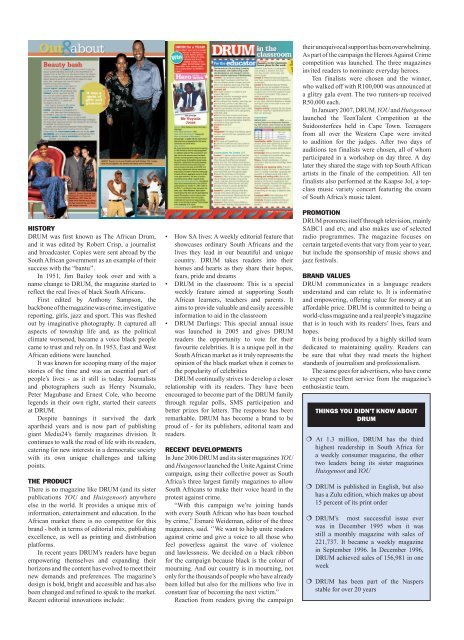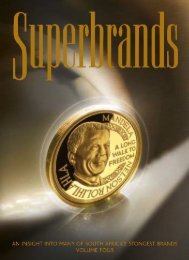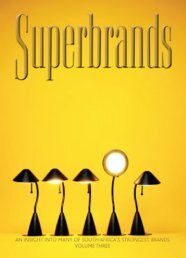South Africa Edition 2
Create successful ePaper yourself
Turn your PDF publications into a flip-book with our unique Google optimized e-Paper software.
HISTORY<br />
DRUM was first known as The <strong>Africa</strong>n Drum,<br />
and it was edited by Robert Crisp, a journalist<br />
and broadcaster. Copies were sent abroad by the<br />
<strong>South</strong> <strong>Africa</strong>n government as an example of their<br />
success with the “bantu’’.<br />
In 1951, Jim Bailey took over and with a<br />
name change to DRUM, the magazine started to<br />
reflect the real lives of black <strong>South</strong> <strong>Africa</strong>ns.<br />
First edited by Anthony Sampson, the<br />
backbone of the magazine was crime, investigative<br />
reporting, girls, jazz and sport. This was fleshed<br />
out by imaginative photography. It captured all<br />
aspects of township life and, as the political<br />
climate worsened, became a voice black people<br />
came to trust and rely on. In 1953, East and West<br />
<strong>Africa</strong>n editions were launched.<br />
It was known for scooping many of the major<br />
stories of the time and was an essential part of<br />
people’s lives - as it still is today. Journalists<br />
and photographers such as Henry Nxumalo,<br />
Peter Magubane and Ernest Cole, who become<br />
legends in their own right, started their careers<br />
at DRUM.<br />
Despite bannings it survived the dark<br />
apartheid years and is now part of publishing<br />
giant Media24’s family magazines division. It<br />
continues to walk the road of life with its readers,<br />
catering for new interests in a democratic society<br />
with its own unique challenges and talking<br />
points.<br />
THE PRODUCT<br />
There is no magazine like DRUM (and its sister<br />
publications YOU and Huisgenoot) anywhere<br />
else in the world. It provides a unique mix of<br />
information, entertainment and education. In the<br />
<strong>Africa</strong>n market there is no competitor for this<br />
brand - both in terms of editorial mix, publishing<br />
excellence, as well as printing and distribution<br />
platforms.<br />
In recent years DRUM’s readers have begun<br />
empowering themselves and expanding their<br />
horizons and the content has evolved to meet their<br />
new demands and preferences. The magazine’s<br />
design is bold, bright and accessible and has also<br />
been changed and refined to speak to the market.<br />
Recent editorial innovations include:<br />
• How SA lives: A weekly editorial feature that<br />
showcases ordinary <strong>South</strong> <strong>Africa</strong>ns and the<br />
lives they lead in our beautiful and unique<br />
country. DRUM takes readers into their<br />
homes and hearts as they share their hopes,<br />
fears, pride and dreams<br />
• DRUM in the classroom: This is a special<br />
weekly feature aimed at supporting <strong>South</strong><br />
<strong>Africa</strong>n learners, teachers and parents. It<br />
aims to provide valuable and easily accessible<br />
information to aid in the classroom<br />
• DRUM Darlings: This special annual issue<br />
was launched in 2005 and gives DRUM<br />
readers the opportunity to vote for their<br />
favourite celebrities. It is a unique poll in the<br />
<strong>South</strong> <strong>Africa</strong>n market as it truly represents the<br />
opinion of the black market when it comes to<br />
the popularity of celebrities<br />
DRUM continually strives to develop a closer<br />
relationship with its readers. They have been<br />
encouraged to become part of the DRUM family<br />
through regular polls, SMS participation and<br />
better prizes for letters. The response has been<br />
remarkable. DRUM has become a brand to be<br />
proud of - for its publishers, editorial team and<br />
readers.<br />
RECENT DEVELOPMENTS<br />
In June 2006 DRUM and its sister magazines YOU<br />
and Huisgenoot launched the Unite Against Crime<br />
campaign, using their collective power as <strong>South</strong><br />
<strong>Africa</strong>’s three largest family magazines to allow<br />
<strong>South</strong> <strong>Africa</strong>ns to make their voice heard in the<br />
protest against crime.<br />
“With this campaign we’re joining hands<br />
with every <strong>South</strong> <strong>Africa</strong>n who has been touched<br />
by crime,’’ Esmaré Weideman, editor of the three<br />
magazines, said. ‘’We want to help unite readers<br />
against crime and give a voice to all those who<br />
feel powerless against the wave of violence<br />
and lawlessness. We decided on a black ribbon<br />
for the campaign because black is the colour of<br />
mourning. And our country is in mourning, not<br />
only for the thousands of people who have already<br />
been killed but also for the millions who live in<br />
constant fear of becoming the next victim.”<br />
Reaction from readers giving the campaign<br />
their unequivocal support has been overwhelming.<br />
As part of the campaign the Heroes Against Crime<br />
competition was launched. The three magazines<br />
invited readers to nominate everyday heroes.<br />
Ten finalists were chosen and the winner,<br />
who walked off with R100,000 was announced at<br />
a glitzy gala event. The two runners-up received<br />
R50,000 each.<br />
In January 2007, DRUM, YOU and Huisgenoot<br />
launched the TeenTalent Competition at the<br />
Suidoosterfees held in Cape Town. Teenagers<br />
from all over the Western Cape were invited<br />
to audition for the judges. After two days of<br />
auditions ten finalists were chosen, all of whom<br />
participated in a workshop on day three. A day<br />
later they shared the stage with top <strong>South</strong> <strong>Africa</strong>n<br />
artists in the finale of the competition. All ten<br />
finalists also performed at the Kaapse Jol, a topclass<br />
music variety concert featuring the cream<br />
of <strong>South</strong> <strong>Africa</strong>’s music talent.<br />
PROMOTION<br />
DRUM promotes itself through television, mainly<br />
SABC1 and etv, and also makes use of selected<br />
radio programmes. The magazine focuses on<br />
certain targeted events that vary from year to year,<br />
but include the sponsorship of music shows and<br />
jazz festivals.<br />
BRAND VALUES<br />
DRUM communicates in a language readers<br />
understand and can relate to. It is informative<br />
and empowering, offering value for money at an<br />
affordable price. DRUM is committed to being a<br />
world-class magazine and a real people’s magazine<br />
that is in touch with its readers’ lives, fears and<br />
hopes.<br />
It is being produced by a highly skilled team<br />
dedicated to maintaining quality. Readers can<br />
be sure that what they read meets the highest<br />
standards of journalism and professionalism.<br />
The same goes for advertisers, who have come<br />
to expect excellent service from the magazine’s<br />
enthusiastic team.<br />
THINGS YOU DIDN’T KNOW ABOUT<br />
DRUM<br />
At 1.3 million, DRUM has the third<br />
highest readership in <strong>South</strong> <strong>Africa</strong> for<br />
a weekly consumer magazine, the other<br />
two leaders being its sister magazines<br />
Huisgenoot and YOU<br />
DRUM is published in English, but also<br />
has a Zulu edition, which makes up about<br />
15 percent of its print order<br />
DRUM’s most successful issue ever<br />
was in December 1995 when it was<br />
still a monthly magazine with sales of<br />
221,737. It became a weekly magazine<br />
in September 1996. In December 1996,<br />
DRUM achieved sales of 156,981 in one<br />
week<br />
DRUM has been part of the Naspers<br />
stable for over 20 years

















